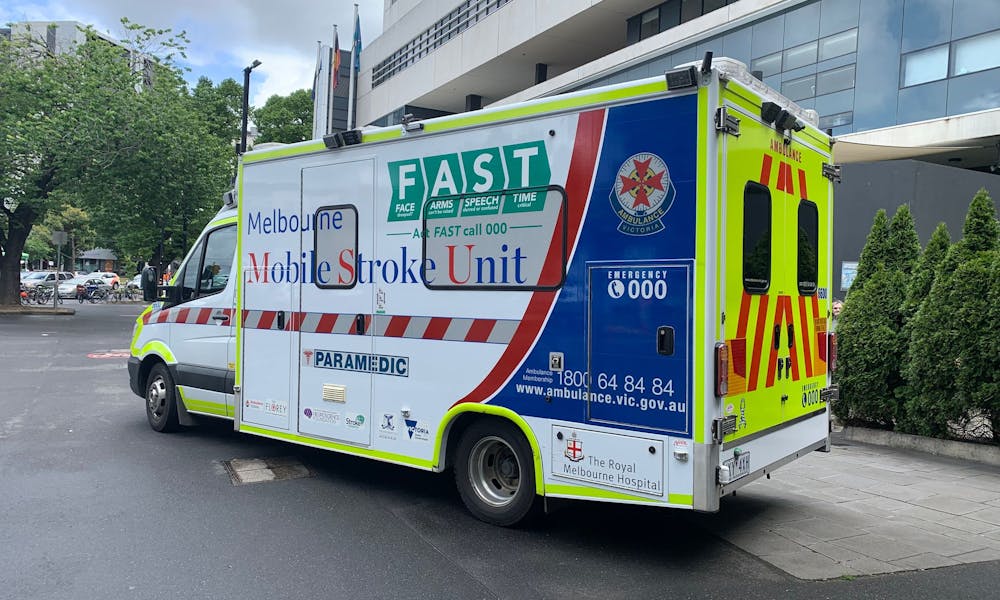The first of its kind to hit the road in Australia, Melbourne’s highly successful Mobile Stroke Unit (MSU) has treated thousands of patients and changed the outcomes of so many Victorians.

The MSU is a purpose-built, 5.3 tonne ambulance which has an on board CT scanner capable of imaging a patient’s brain to detect the type of stroke they are having. This means assessment and treatment can begin immediately, rather than after they arrive at hospital.
The MSU, a joint venture between the Royal Melbourne Hospital (RMH), the University of Melbourne and Ambulance Victoria (AV), has treated 2,735 patients since 2017, with 55 per cent of patients being diagnosed with a stroke or mini stroke.
The specialist ambulance conducts life-saving diagnosis and treatment at the scene of the stroke. Onboard is a uniquely equipped team consisting of two paramedics, a neurologist, radiographer and a stroke nurse.
The RMH’s Director of the Melbourne Brain Centre, Professor Stephen Davis AO said patients identified on the MSU as needing additional advanced stroke treatments, such as endovascular clot retrieval or neurosurgery, are transported to specific specialist centres, saving the health system $270,000 in reduced hospital bypasses.
“When it comes to stroke, every minute counts, and the MSU has demonstrated in its five years, how invaluable the time to treatment is, seeing patients walk out of hospital after only a few days following a major stoke is extraordinary,” Prof Davis said.
The MSU average treatment time was 34 minutes after arriving at the scene, compared to 78 minutes treatment in an Australian hospital.
Senior team manager of the MSU for AV, Leigh Branagan explains that when a person experiences a stroke up to 1.9 million brain cells die every minute, so time is of the essence. In these cases, time saved is brain saved.
“Thanks to the Mobile Stoke Unit, patients receiving time-critical clot-dissolving treatment within the first hour after symptoms – the ‘stroke golden hour’ – increased 12-fold from 1.5 per cent to 18 per cent,” Mr Branagan said.
The RMH's lead radiographer for the MSU, Francesca Langenberg said whenever possible, a clot-busting medication is given at the scene after a brain scan has been conducted in the back of the ambulance.
“We scan. We treat. And I see a patient get better in front of my eyes. There’s no better feeling. They can go from being severely disabled and by the time we get to hospital, they’re speaking again,” Ms Langenberg says.
University of Melbourne Professor of Neurology Geoffrey Donnan AO and co-founder of the MSU said another part of its success is that it can be used for research and trials.
“The MSU is a unique mobile clinical trial site, providing data on novel pharmaceuticals and modifications to urgent stroke care which, in turn, lead to changes in international clinical practice,” Prof Donnan said.
It’s patients like 83-year-old Tony Gould who are forever grateful for the quick work of our “hospital on wheels”.
For Tony, it was a regular day with a visit to his local café, when he noticed his right arm had gone numb and he couldn’t move his hand. The café staff were quick to call triple-0, and due to the nature of his symptoms the MSU was also dispatched.
After his assessment he was given clot busting treatment which relieved his symptoms instantly.
Anthony, who is a Doctor of Music and pianist, left hospital within two days with no disability or side effects.
After meeting the crew that saved his life, he was speechless and very humbled, “thank you all so much, you not only saved my life but also my career and my passion, I am so grateful,” he said.
Key MSU results over the last five years:
- In the most common type of stroke due to brain clots (ischaemic stroke), the stroke ambulance delivers immediate clot-dissolving treatments at the patient's doorstep
- Early treatment is critical as reopening the blood vessels even minutes earlier may save the patient from a lifetime of disability
- In the pilot period, the MSU treated over 200 patients with the clot-dissolving treatment. Accounting for operational hours, this is equivalent to over 100 patients treated over a 365-day year, making the stroke ambulance the busiest clot-dissolving treatment service in Australia.
- Treatment delivered on the stroke ambulance means that stroke patients can receive this vital medication in approximately half the time had they gone with a regular ambulance to hospital
- Some 18 per cent of patients on the stroke ambulance receive clot-dissolving treatment within an hour after start of their stroke, compared to 1.5 per cent in hospital
- For specialised treatments including clot retrieval and neurosurgery, the stroke ambulance has been able to diagnose and direct some 123 patients away from the nearest hospital to a comprehensive stroke centre. Bringing the right patient to the right hospital saves valuable ambulance resources and ensures patients receive important surgical treatments hours earlier.
Life changing results:
- Around two-thirds of all patients treated on a stroke ambulance will return to independence after receiving clot-dissolving treatment
- It has been shown, internationally, that for every 100 patients treated on a stroke ambulance, 27 would have less final disability and 11 more will be disability-free
- The impact on outcomes of giving earlier clot-dissolving treatment on a stroke ambulance is almost as strong as the difference between patients receiving treatment versus not receiving treatment at all in hospital.

We provide a media service from 6am to 9pm each day. Journalists are welcome to contact our media adviser on-call via the RMH Switchboard on (03) 9342 7000.
During business hours, journalists can email mh-communications@mh.org.au. We do not respond to emails outside business hours.

